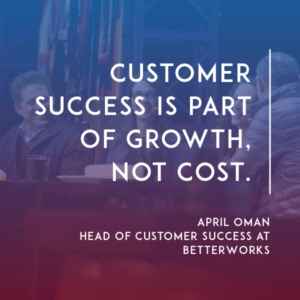Customer success is a relatively new function within SaaS organizations, but luckily, we’re moving past the days where it gets confused with customer support. Santi Subotovsky from Emergence Capital sits down with three customer success gurus: David Obrand, COO at Radius Intelligence; April Oman, previously Head Of Customer Success at Zuora; and Sarah Kokin Jacobsohn, Director Client Success Services at Cornerstone OnDemand.
What considerations should be kept in mind as you chase those upsells, cross-sells and expansion? For one, April, David, and Sarah all agree that retention is the most important metric that a customer success team should nurture. On the other hand, you should also be very careful about the customers you bring on because you may spend more resources trying retain a customer that wasn’t a good fit for the company in the first place. The three of them also discuss how to think about comp structures for customer success folks and how it relates to sales.
Check out the full transcript below!
If you want to see more sessions from SaaStr Annual, we’re releasing a new one each week. Subscribe here to be notified. And be sure to grab your tickets to the next SaaStr Annual NOW.
TRANSCRIPT
Santi Subotovsky: Hello, everyone. I’m Santi Subotovsky, General Partner with Emergence Capital. I’ve been in the SaaS space for, I was counting, so almost 15 years. I started a SaaS company before it was even called SaaS, it was ASP for those of you who remember it, and started in Argentina. Had nothing like this before. Jason, thanks very much for putting this group together.
What’s this? We have a cake here. That’s Jason. He’s been sending emails back and forth. He said he was going to bring in a cake to celebrate that I’ve been promoted at Emergence, so thank you. I thought he was just kidding, so thank you guys.
[applause]
Santi: Feel free to get some cake after the panel. I have the pleasure of sitting in this panel with great people who’ve observed the customer journey in great companies Sarah of Cornerstone, April, and David at Radius Intelligence.
I’ll let them do a 30 second intro on themselves and the companies that they are with. The questions that I’m asking you is why did you decide to join these companies? You could probably join any company in the world and you’re at companies that you’ve picked. It’d be great hear a little about your journey. Sarah, you…
Sarah Kokin Jacobsohn: Sure. I’m Sarah Jacobsohn. As Santi mentioned, I’m with Cornerstone OnDemand. For those of you who are not familiar with Cornerstone, we’re a provider of talent management solutions. Essentially, we allow organizations to manage the employee life cycle, so recruiting, training, performance, etc.
I actually joined Cornerstone 10 years ago when we were pre-venture funding around seven million in annual revenue. We’re announcing earning tomorrow so if you want to know what our revenue is for 2015, you can join in on that, our earnings announcement.
I joined Cornerstone for the people, actually. I was so impressed by the people and so impressed by the culture that it just seemed like an awesome place, an awesome company to be a part of.
I was excited to join a startup at that time and be a part of a journey and then part of a fast growing company. For those reasons, I haven’t left. It’s been a fast growing company ever since. I still continue to work with amazing people and love what I do.
Santi: Thank you.
April Oman: Hi, everyone. I’m April Oman. I’m currently the head of customer success at BetterWorks. I’ve spent five years at Salesforce, spent a bit of time at Cornerstone OnDemand. Then I was at Zuora most recently for three years.
I joined BetterWorks, which is an enterprise goal management platform that really is intending to ensure openness, connectedness, transparency in organizations tracking aspirational goals, so that ultimately they become efficient and effective at whatever their mission is. I’ve been in Customer Success my entire career and I’m really excited to be here on this panel.
David Obrand: Wonderful. Good afternoon. I am David Obrand. I’m COO at Radius and we’re a Betterworks customer, love your product…
April: Thank you.
[crosstalk]
David: …product. I spent 10 years at Salesforce.com and then several years at a company called Yammer and I have been at Radius for little bit over a year. In my capacity we look at customer success in sales as just one organization called the customer organization. So, pleasure to be part of the panel today.
Santi: Thank you. We’re going to start with the very basics. Remember, when I joined Emergence five years ago, I was looking at SaaS companies from an investor point of view. We spent a lot of time looking at upsells, cross-sells and expansions. What we’ve noticed is that a lot of the entrepreneurs just focus on new logos and that was the only way that you saw they could grow their companies.
What we’re trying to do when we were looking at those companies is figuring out new logos matter, but then expansions, cross-sells and upsells matter a lot and they help you grow more efficiently. We’re going to start with the basics. We’re going to ask Sarah to just share the basics.
What do you mean when you talk about upsells, cross-sells, expansions? Is that part of the sales organization? Is it customer support, customer success. Is it the same people who need to track those metrics?
Sarah: So the way we define upsell, that’s really the addition of additional licenses that a company may purchase for existing products that they have. Expansion for us is, you have multiple products to sell that you’re able to sell those additional products to your customers. I’m sorry, cross-sell is selling additional products if you have additional products to sell to your customers.
And expansion is the ability to sell your solution into other subsidiaries within an organization. Oftentimes you may sell into one subsidiary or one department and expansion is really the ability to grow that relationship.
Santi: Is this part of the same organization. Does all fall within the customer success organization or is it part of the sales org?
Sarah: Great question. In order to answer that it’s important to understand the client lifecycle. At Cornerstone we think about the initial sales process and once that contract is signed, what the post sales process is. I like to think of it as a dating, then the marriage with the contract its serving is that wedding and then beyond that is the marriage.
[laughter]
Santi: Kids…and you have to deal with a family.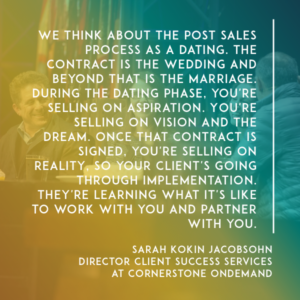
Sarah: Exactly. Sometimes tension for that matter. During that dating phase, if you think about it, you’re really selling on aspiration. You’re selling on vision, you’re selling on the dream and that’s its own unique skill set. Once that contract is signed you’re then selling on reality, so your client’s going through implementation. They’re learning what it’s like to work with you and partner with you and you have to sell through that.
You all know there’s going to be challenges. Things don’t work perfectly. This is software and so it’s a different skill set that’s required to help to manage that relationship and to sell through that experience that a client has had.
For us it’s two unique functions that sit within the sales organization, one that’s very much focused on that initial sell and then and one that’s really focused on the expansion upsell and cross-sell, in what I call the marriage.
Santi: That’s cool. April, you worked for some of the best SaaS companies in the world. You’ve seen this customer lifecycle at these different companies.. Do you feel that customer success is a function within a company, just like I mean the sales group. They get the new logos and then they hand it over to you guys to do whatever you want to do, or is it more than just a function within a company?
April: Let’s start off with, it is a function. This can be a very real career for many of you out there. I wouldn’t have a job if we didn’t have customer success. Customer success really is both the mindset and it’s a function.
When you think about a prospect, who first starts to understand and be aware of your brand and of your company, you need to woo them and you need to understand why they’re buying. What it is that there really looking for, and the challenges that, that they are in fact trying to address.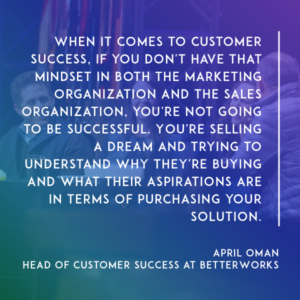
When I think about customer success, if you don’t have that mindset in both the marketing organization and the sales organization, you’re not going to be successful because you are selling a dream and you are at that point really trying to understand why they’re buying and what their aspirations are, in terms of them purchasing your solution.
The idea of customer success in a post live scenario is the implementation. It’s the nurturing of that relationship, which then gives you if you’ve it done it well, the right to ask for the upsell, the cross-sell and the expansion.
You would also expect your customer success team to be responsible for retaining that customer, ensuring that churn does not occur, getting the customer to advocate on your behalf, even when you’re not in the room. Those two things will allow you to grow in the market.
Santi: David, this is a question for you. You hired a lot of people for different sales organizations and when you think about customer success, what are you looking in that first customer success hire? When is it too early? When is it too late and when is the right time to bring in that person?
David: I don’t think it’s actually ever too early. I actually think that if you are starting a company, you would start with engineering and product to prove out the thesis, but you would want actually to start building out customer success even prior to building out sales.
In those early days customer success is a critical role because you’re actually soliciting feedback from those early adopters that go into the product roadmap and you think about how you iterate with repeatability for a broad base of customers as you start to expand the TAM.
Santi: Isn’t that the role of the CEO, those early stages?
David: I think in the early days it’s the role of everybody, because you have some bright engineers and product people but you have to figure out if the thesis is even valid. You want to talk to a wide range of different prospects.
You don’t have any customers by definition when you start, but as soon as you bring that first one on, ultimately your goal is to harness the customer army. You have thousands of customers selling on your behalf, but it starts with the very first one. One gets you two; two gets you five; five gets you 20; and so on.
It’s really important that you understand that customer journey with the new product and it’s very different when it’s those early days of the product versus when you’re on version 10, 12, and 15. For us, what we think about from a competency perspective is, we think about just raw intellectual horsepower is the first thing we look for.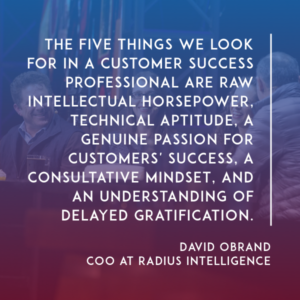
Technical aptitude, most of the products we are building and taking to the market today fit within an ecosystem, they’re not a silo. You have to understand the ecosystem that it fits within.
The third one is you really want to look for a genuine passion for customers’ success. For example, anybody we hire in a customer facing role, we look for two customer references before we bring them on board. It’s really important. The fourth one is that consultative mindset. For most of us, we’ve moved away from selling features and functions and we’re selling around use cases.
Understanding that consultative mindset and how customers behave today and abstinate and constraints [10:41], how would they like to operate to move faster, be first movers in their market. Then the fifth one we actually look at, we call it it’s the athlete or the musician variable. For us, we want people that really understand delayed gratification.
They won’t take the deal down as soon as they can get it, but actually want to make sure it sticks. Ultimately, as you think about customer success in churn and renewals, really what you want to do is you want to make sure that customer’s as self sufficient as quickly as possible with your technology, and has been able to measure the value, they’ve been able to extract from the investment.
If you can get that done in the first 90 to 120 days of a relationship, you’re almost guaranteed to get the renewal on the upsell.
April: Can I add one more thing to what you said? I think the other skill set that I would look for in a customer success professional would be aptitude to understand when things are not going well and be able to turn around the relationship, but also learn from the experience.
If you’re in a fairly young company and you have a customer success professional, I would ask them to really understand the customer journey and understand what the customer is really trying to do at every single touch point in their relationship with you. Once you understand what their experience is, you’re going to learn from that.
That will tell you how you will need to price and package, how you need to go to market, how you need to service them, what services are actually needed for every different segment of the market that you’re actually trying to target? Because your SMB space is a lot different to serve than your enterprise space. That might be one more thing that I would add to the wonderful list that you created.
David: Yeah, I agree. For us as we went on this journey at Radius, we actually use BetterWorks. While I think customer success is a function, I actually think it’s a core value. We actually use BetterWorks to help drive that core value, because I do think it’s…
April: Thank you.
David: You’re welcome, and…
Santi: This wasn’t planned.
David: It wasn’t. I wasn’t paid for that. It’s like Peyton and Budweiser.
[laughter]
David: In those early days, you’re going to fail fast and you have to learn along the way. It’s not just the customer success team that you want to represent your customer. You want everybody in the organization to genuinely feel passionate about making sure that customer is successful.
Whether it’s the product marketing content, or the product itself, or the pace with which you iterate, how you give support, how you represent it from a sales perspective.
April: Engineering, how they built the product?
David: Absolutely, yep.
Santi: What’s the most important metric that customer success owns? There’s a lot of metrics like renewals, churn, NPS. If you had to pick one metric, the one that everyone in your organization is going to look at every day, what…?
Sarah: Retention.
Aprl: Retention.
Sarah: Especially early on, because it’s all about those customers that you have at the beginning. They’re almost doing the sale for you. They can talk to, how they’ve been successful with your solution.
They can be of serve as a reference for you. You need your earliest customers to be raving fans for as long as possible. In the early days at Cornerstone, we would do everything possible to retain all of our customers. That was our number one priority.
David: I would add as part of that, user engagement. If you have user engagement, you should get retention as a byproduct of it. To me, those two go hand in hand. Ultimately, you want to make sure you retain them so you don’t have churn and you can continue to triple and quadruple every year.
At the same time, you really want these customers extracting so much value that they’re calling you wanting to be a reference so they can tell their story. I think that’s what Salesforce did a great job of with customer heroes, for example. Customers wanted to be a reference. You want that passion in your customer base around the products and services you deliver.
Santi: At these early stages retention is important. Would you go out of your way and provide a lot of consulting, professional services just to retain customers? It’s not that we haven’t seen that before.
April: Oh, yes.
Sarah: Early on absolutely.
April: You need a few flagship customers that are going to help you expand in the market. Now I think the question that many of us struggle with is how much to invest before you really start losing your shirt. Part of it is understanding your cost to acquire and then also your cost to serve. Those might be two metrics that I think are worth looking at.
Then I think you have to understand the value of that customer in your ability to get new prospects to sign to a customer. You might decide to invest in a particular logo, or a particular geography, or a particular vertical so that you can demonstrate success in that particular area which then feeds on your ability to get more customers in that respective market.
You just have to be intelligent about how far you’re willing to go in terms of that investment and what does that actually look like. Typically most organizations, I would assume of your size, this is what I have done, which is, you throw services at it.
Then it tells you, which is cool, is that you learn what level of service you have to provide in order to ensure different segments of your customer base are successful. Again, your SMB is going to be a lot different than your enterprise customer.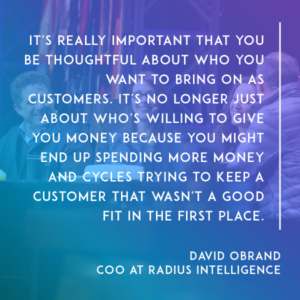
David: Yeah, I would add to that especially in the beginning. It’s really important that you be thoughtful about who you want to bring on as customers. It’s no longer just about who’s going to be willing to give you money, because you might end up spending more money and more cycles just trying to keep a customer that wasn’t a good fit in the first place.
It’s really important to be thoughtful about what that ideal customer profile looks like and making sure you’re bringing on customers that, not only you’re a good fit for, but are a good fit for you based on where you are in your evolution as a company.
April: That’s about being focused and understanding your market and where your product is going to play well, versus where your product’s not going to be well and you’re trying to jam a square peg into round hole.
David: Exactly.
Santi: Can you share an example of a time that, it could be any company that you work with, where you brought in a customer just because it was a great logo, or big cheque, or your investors were saying, “Oh, you should bring in more revenue.” Then you ended up firing that customer.
David: I think someone’s uniquely suited to answer that question on this panel.
April: Merrill Lynch Salesforce, would be the one that I would use. That was our first flagship customer, our first customer in the financial services space. We didn’t fire that customer though, but there was quite a bit a turnover on the account. I was very fortunate at that time, Tien, who is now the CEO of Zuora, he was my executive sponsor for a short period of time.
What we learned, and this was in 2007, in 2006, 2007, when I owned that relationship. What we really had to do to ensure that they were absolutely successful is really run it like a program. Every single week any person that had any sort of touch point including sales with this customer, I ran a call and we went through every single goal that we were trying to accomplish for that respective week.
We made sure that we were absolutely aligned on the message and the approach that we were going to take. Then following that, I had actually a call with the customer and ran through everything. There was a very methodical way of managing the relationship.
The other one maybe perhaps funny story, still kind of funny to me, but when we managed that relationship, there were a couple of escalations. You can expect that when you’re managing a customer who knows that they’re dramatically important to your ability to be successful as a company that they threaten to call.
I had already arranged with Parker Harris, as most of you know, he’s one of the founders of Salesforce, that if the customer called him, he was not to call them back. He was to call me first. Then we would decide what he would say, then he could call them back.
Having alignment across your entire organization in terms of how you’re going to manage these very critical customers to your business is really important.
Santi: That’s easier for larger organizations where you can fund the growth with capital coming from other places, but what do you do when you’re a small startup? Would you kill your company by saying no to a large customer who’s handing you a ton of cash?
April: Do one of you want to answer that?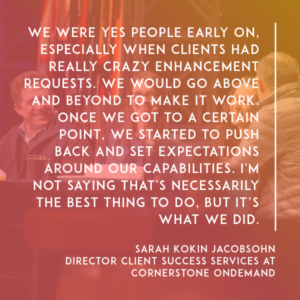
Sarah: We were never good at that. We were yes people early on, to be honest with you, especially when clients had really crazy enhancement requests. We would go above and beyond to make it work early on.
Once we got to a certain point, we started to push back and set expectations around what we were capable of doing, but early on, we would do what it took to win the deal.
I’m not saying that’s necessarily the best thing to do, that’s just what we did.
David: I do think it’s important that you do everything you can to make your customers successful. That being said though, you want to make sure that you are not architecting yourself into a corner, or taking yourself off of your roadmap.
What’s really important, and we experienced this at Yammer, when you’re building for thousands of companies or millions of users, is you start building one offs, it slows down your cadence and your ability to innovate and iterate.
You have to start testing all those. All of those one offs, you have to test every time you come out with a new release. Now your burn goes up, because you have more QA people, your development cycles get longer, your pace of innovation gets longer, your roadmap extends for years now rather than months and quarters.
It’s important to have that consultative conversation with the customer. If I understand, this is what you may need or want, but let’s talk about other ways that we can solve that problem in a way that’s repeatable across the broad customer base, because, ultimately, part of the reason you chose our technology is our pace of innovation, and we can’t provide you that if we’re basically building custom consulting engagements.
Sarah: We didn’t make one off solutions. We would just add that to the roadmap, and deploy that to everyone. It sometimes just wouldn’t happen as quickly as the client would like, but we would just build them the product.
April: You can manage expectations.
Sarah: Exactly.
April: That means that really you have to demonstrate ROI very early, and make sure that you have a really strong champion, and in some cases more like a program lead, the person who handles some of the day to day stuff.
If you’ve demonstrated quick wins, customers getting ROI to some extent, and you’ve got a really strong executive champion/economic buyer for the most part, you can manage those expectations.
You still sometimes have to deliver stuff that you’re initially like, “Why am I doing this?”
Sarah: And you don’t really want to do in the first place. [laughs]
Santi: With a background in economics, people respond very well to incentives. When you’re hiring your team, if you’re telling them retention is the number one metric, and you’re going to get a bonus if your retention rate is over 95 percent, how do you make sure that they’re retaining the right customers, and not just retaining 95 percent of the customers to get the bonus?
April: Don’t sell to the wrong customer.
Sarah: Yeah.
Santi: But that’s a problem with sales. Sales sold to this customer, now you need to retain the customer.
April: Hey I’m in sales too, even though I’m head of customer success. I’ve got one boot in sales, and one boot in the customer camp. In terms of, how do you want to compensate your customer success organization?
Do you want to compensate them on renewals? Do you want to compensate them on the upsells, the expansions? The answer is in my experience, I have worked in organizations where we didn’t compensate customer success and in organizations where we did.
The answer, at least I think you should. It doesn’t mean that they’re salespeople. It’s a very, very different role, but you do want to motivate them to ensure that when the customer’s coming up for renewal, that they’re having that renewal conversation, and that they’re looking for those expansion opportunities, even though they may not own the sales campaign.
The account executive may own the sales campaign, but you need them to be in there making sure that they’re having those conversations with the customer and seeking those opportunities out, because you don’t want to distract your account executives with upsells and expansions when their primary function should be new business, but they should partner very, very closely together. Anything to add?
Sarah: We separated out. As I spoke to you earlier, we have a sales team that’s focused on initial sell, we have a sales team that focused on the expansions and the upsells and the cross-sells.
The retention is…we incentivize people not so much on the retention piece, but more on the upsell and the renewal, and achieving the renewal.
Santi: Do they carry a quota?
Sarah: Yes they do.
Santi: They do. Have you seen any comp structures for customer success that were messed up, David?
David: Yes. It’s really important, as you think about comp for customer success, you rethink comp for sales as well.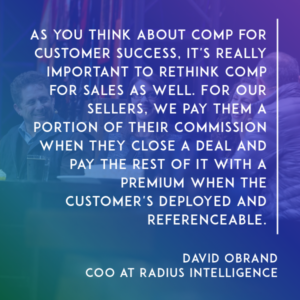
One of the things that we’ve moved to is for our sellers, we’re actually paying them a portion of their commission when they close the deal, but the rest of it with a premium when the customer’s deployed and referenceable.
When you think about it, the only person that really celebrates when the deal’s done is the salesperson. Finance isn’t paid yet, so they’re sort of holding their breath.
[laughter]
David: The engineers built this great product, but the customers are not really using it yet, so they don’t celebrate. The customer spent a bunch of money but they don’t have any value yet. The only person that’s really celebrating is the salesperson.
Once that’s deployed and the customer’s referenceable, engineering feels great, because they’ve effected change in a company based on code they wrote. Your finance guy or gal are happy because they got paid. The customer gets value, so they feel really good about it.
That’s a great rallying cry for everybody. As you reorient sales compensation, you can start to reorient customer success comp. It is very important for customer success to be able to sit down with the customer and say, “I don’t care if you don’t ever buy anything again. My job is to make you wildly successful with the investment that you’ve made.”
They should be observant enough, and where they see opportunities for more use cases and upsell, cross-sell, they should be able to guide back to the sales rep and say, “I think there’s an opportunity here.”
But ultimately, if you are compensating customer success on retention, that’s great. I think that’s a great metric that they can feel good about. They affect change in the organization, but they can still stay true to their vision.
April: Which is make the customer wildly successful as quickly as possible.
David: Yeah, exactly.
Santi: I want to switch gears a little bit and move into how do you manage these customer success teams when you’re going into different industries?
David, you had a great experience with freemium models. April, you’re looking at enterprise customers. Sarah, you’ve seen that entire customer journey.
How do you do this differently when you’re focused on SMB, enterprise, and freemium? Is there any difference or is it just same thing?
Sarah: Who wants to go first.
April: You’ve seen the hole.
[laughter]
April: You do have to address their different needs. Your SMB is a lot different than enterprise, especially with respect to expectations. We should probably talk about one to many strategy. Do you want to talk about that?
Sarah: Yeah, sure. You know what, go first. [laughs]
David: I’ll go. You asked about freemium, and we saw a lot of that at Yammer. Freemium is great. If you think about the different personas that are involved in bringing the technology into a company, one of the challenges IT has is building a product and then being a cheerleader for its adoption.
The nice thing about freemium is you don’t worry about that, because you’ve already seen user engagement, and you know what you deliver, the users are going to like, because they self discovered the product and they’ve applied it to their own business case or use cases, and you’ve seen the right level of engagement.
It’s important in freemium to understand that users use but companies buy. There are some companies their users can buy individually, but ultimately you have to roll that up. If you roll it up, it’s a different set of criteria that you have to engage the organization in discussions around.
It’s very helpful. A lot of times, and you remember we found this at Yammer, some of the fastest sales cycles were not the ones that started with freemium. They were the ones where the companies didn’t allow it all.
When we went in and we established value, and we talked about Orion and the technology around accelerating specific use cases, that’s where we started to see quick buy in and then drove the adoption.
Whether it’s freemium, or enterprise, or SMB, you still have to think about a company’s cultural ability to consume change, the deployment plan you want them to be able to get value quickly, so it’s that crawl, walk, run.
What are use cases that we can deploy quickly that don’t affect a large change within the organization, but they can get value quickly, solve quick pain points?
Then it’s all about communication to the organization deployment planning. Then it’s…
April: Success metrics to ensure that once you’ve deployed, that you’ve shown that ROI.
David: And the transparency and communication. What works? What doesn’t? We want to have that transparency with the customer. We want to have that transparency back into the engineering and the product organization, to the support team and to the sales team, as well.
We want to tell the sales team, “Look, this was a great deal, but we actually found some use cases we didn’t think of. Had we thought about those earlier on, maybe we could have expanded the deal size, or shortened the sales cycle, or differentiated against the competition.”
Santi: With freemium, let me ask you a follow up question. You said that sometimes when companies were using the free part of the product, that made it harder to upsell or to convert them to the paid.
Should you throttle down the functionality of freemium to make sure that people upgrade?
David: No, I don’t think so. I think you have to be thoughtful. One of the great things about Yammer was our ability to actually see the adoption rate of freemium within companies at the both macro level and individual user level.
You have to be thoughtful when you want to insert yourself into a discussion. It’s important as you drive a technology like Yammer that changes the behavior in a company, there’s a degree that you want to be thoughtful about around being prescriptive.
The longer you let that freemium go, and odd behaviors start to display themselves in how they’re using the technology and where they’re orienting around it, sometimes it’s harder for you to reset around the right set of use cases.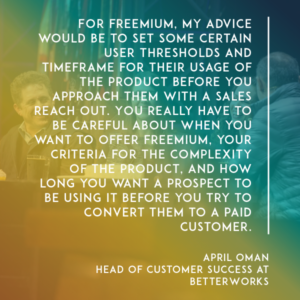
April: I would say for freemium, my advice would be to set some certain user thresholds and timeframe of when they actually get to use the product for free before you actually touch them with a sales reach out that says, “We see that you’re using this way. Let’s talk about why you’re using, what brought you to whatever solution it is that you have.”
The one thing about freemium that I think most organizations sometimes aren’t necessarily cognizant of is that freemium doesn’t work for every type of product.
You really have to be careful about when you want to offer freemium, what’s your criteria for the complexity of the product, how long do you want a prospect to be using the freemium product before you actually start an engagement with them to then try and convert them over to a paid customer.
If I think about my experience at Zuora, which is a commerce, billing, and finance platform for subscription businesses, we didn’t offer freemium because you can’t. It’s really hard to offer a billing engine as freemium.
[laughter]
April: BetterWorks, as an example, is launching a freemium product in the next two months. It’s going to be a situation where sales is going to own that relationship with the prospect until they buy. Then we’ll go through the sales cycle, and then I’ll take even responsible for them.
But even in terms of freemium, if they submit a ticket, who’s the person that’s going to answer the ticket? Is it going to be somebody on the customer success team, or is it going to be a sales development person?
We’ve elected to have a sales development person answer the freemium tickets, because that’s where the person is in their relationship with you at that point.
Sarah: With SMB, it’s really all about making it as easy as possible for the customer to implement your product, to use your product. You have to think about how you make it easy for them.
They’re not resource rich like some of the larger enterprise companies are when they’re implementing SaaS solutions. It’s usually one person who has multiple responsibilities.
For them it’s all about, “How do I do this quickly? How do I do this easily? How do I make this work and start to recognize value as soon as possible?”
Simplifying the process. That’s something that we’ve learned at Cornerstone, to create implementations that are very turnkey and very simple for our smaller customers. That was key to success as we moved down market, and making it easy for them.
Santi: Cornerstone, even though it’s a horizontal platform, you guys have started going after specific verticals that you’re targeting.
April: Absolutely.
Santi: How does it change the way you manage your customer success teams? Is it the same team that’s focused on the horizontal play that focuses on verticals? Do you need a different set of skills?
Sarah: From a client success perspective over time, we started to differentiate or have people very focused on specific industries to manage those relationships.
Early on, because we were the horizontal play, we supported all clients, no matter what industry they were in, but once we had enough clients from a specific industry, we would play off of them.
I used to manage several of our healthcare clients. Once I understood the healthcare market, how they were using our solution, it was all about gathering stories. It was all about understanding how they’re using our product, how they’re driving success, recognizing value, and taking those stories and sharing them with other clients in that same industry who may not be using that product.
That was my opportunity to really cross-sell, was to apply the stories and the successes from one client in the industry to another. It’s all about sharing the stories. I would also do that when we had clients that were struggling.
If I had one customer who was really struggling to use Cornerstone well, I would connect them with a client that was super successful, so they could understand why this other client was having tremendous success and recognizing tremendous value out of Cornerstone, where they were not.
Sometimes the client needs to take a step back and realize for themselves that they’ve made their own mistakes, and that they’re their own worst enemy. They’re not going to take it from us, but they’ll take it from another client when they hear what they’ve done to be successful.
April: That’s really powerful, when you do have that opportunity to start to verticalize, because you’re going to start to identify best practices by industry.
You start to identify the skillsets that you might really need to service a healthcare company versus a financial services company. Then you’ll be able to start to generate those user stories that you need to go sell more into that respective industry.
Over time, as customer success continues to grow as a function, I can see lots of people then, if they’ve got an accounting background, wanting to work with financial services companies, or if you’ve got a healthcare background, servicing customers who’ve bought your platform that happen to be in that respective industry.
Not every company is the same, but if you can create a common path in terms of how they’re using your solution, it’s so easy to connect those two companies together. Using your example, Sarah, because there was common language, there is deep empathy for what the customer is trying to do, and why they actually bought your platform.
Santi: Beyond the conversations that your teams are having with a customer to identify upsell, cross-sell and expansion opportunities, what metrics are you tracking within those customers to initiate those conversations? What tools are you using to track those metrics.
April: Usage.
Sarah: Yeah, usage and adoption.
April: I’ll share the experience that I had at Zuora. We had this thing called subscriber identity. It was really understanding the full picture of who your customer is, why they bought, when they bought, how and when they bought more.
For them, the way they priced and packaged was you paid platform fee, plus you paid for usage that you would put through the system. We would monitor how much volume a respective customer was putting through the actual system relative to what was they contractually had bought.
You could start to predict three months, six months in advance when they were going to actually hit the threshold of being over for what it was that they actually purchased.
If you have the tools in place, Zuora has subscriber insights, at BetterWorks I used Gainsight, which is a customer success tool. I use that product to understand how customers are using and when they’re using.
If a customer by chance usage drops, then that triggers an alert to the respective CSM who owns that account, and then they go and run a playbook with that respective customer to understand why their usage dropped.
That’s the primary one.
David: Two things. We do something very similar. We capture user engagement on the back end, that actually feeds into Mixpanel, which feeds into Gainsight, which feeds into Salesforce.
Customer success for us starts halfway through the sales cycle. We don’t have a hand off at the end, it’s one contiguous process. Everybody who is customer facing on any account…Merrill Lynch would be a lot easier, right?
April: Yes.
David: We can now see everything’s green, yellow, and red. We can see user engagement. We can see new users that come on. We can see how they’re consuming the technology, how many segments they’re building, how many net new leads they’re deploying and all that.
The other thing that I think is really valuable where it’s appropriate given the technology or service that you have is use your own product. For us, Radius on Radius. I’m sure BetterWorks uses Betterworks. Salesforce uses Salesforce. Yammer uses Yammer.
You get tremendous insight and empathy when you actually go through the journey of using your own product on a daily basis. It’s a great story to actually chronicle, and then share with customers and prospects as well.
Santi: This is a question that we struggle a lot when we’re looking at companies, and the answer is not that clear. Is customer success part of COGS, or is it part of sales and marketing?
April: Growth. It is growth.
April: I would say that support is probably cost. But a customer success manager, who is managing that relationship and is responsible for retention, responsible for identification of upsell and expansion and getting that customer to advocate, that’s a growth.
Santi: So it’s not COGS?
April: No, it’s not cost.
[crosstalk]
[laughter]
David: I love the philosophy of thinking about it as COGS, though, but I think it’s growth.
Sarah: I do, too. Our client success reps, they’re selling.
Santi: We have 3 minutes. Do you think what’s happening in the markets is going to affect your groups and the way people are going to look at the efficiency and the leverage that you can generate for the businesses?
April: I don’t think so.
Sarah: I don’t think so either. It does largely depend on iF your solution is a must have versus a nice to have. I think of Cornerstone as more of a must to have solution.
No matter what is going on in the market, companies still are going to have a need for our solution to manage processes, to manage their employees. They’re going to invest in the product. They’re going to invest in the solution.
Santi: But what about your function? Is customer success going to be more important or less important?
Sarah: I think it’s going to be more important. To drive retention, to drive the growth through the expansion and cross-sell and upsell. We’re critical to the success of the business from a revenue perspective.
I can’t see us going away anytime soon.
Santi: April, you mentioned customer support as part of COGS and customer success as part of the growth engine. I remember when I started the company 15 years ago, it was all about customer support. There was no customer success.
Isn’t customer success just a fancy term for customer support?
April: I define “Support” as our agents who are answering tickets that are submitted by customers. They’re typically break, fix, performance type questions. It’s, “How do I do X? How do I do Y? Provision me for this. Turn on this feature. Turn off this feature.” That is support.
Typically, support is part of a customer success function. If you want to break out the finances of it, I think fundamentally because support is a transactional relationship, that should be part of cost.
When I think about the customer success manager, they’re driving the implementation, they’re driving the retention and everything that Sarah and David have already said.
Santi: We’re running out of time. Do you have any final comments for the audience? A lot of people in the audience are starting companies, so starting to think about customer success.
I remember when I started the company, it was usually product and sales, and customer success was an afterthought, which was a mistake back then. Any words of wisdom?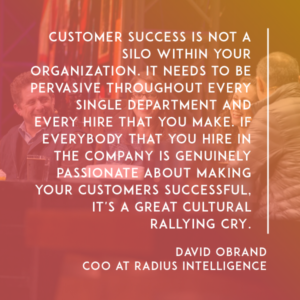
David: The only thing I would say is when you think about customer success, it’s not a silo within your organization. It needs to be pervasive throughout every single department you have and every hire that you make.
If everybody that you hire in the company is genuinely passionate about making your customers successful, it’s a great cultural rallying cry.
It will ensure that you’re bringing in the right customers and the right revenue, so your cost of maintaining those customers and growing them is much lower.
If the mindset across the organization is driving value and self sufficiency for the customers, what you will find is you can get to that 4x, 5x year over year growth much faster, because your customers will actually take on a large burden of that selling and marketing for you.
April: The world has shifted. If you think about the subscription economy, how many of us are buying things today? We’re typically subscribers.
If you’re not out there nurturing that relationship and continuing to give them value over time, they’re going to go find some solution that actually does.
I want to encourage all of you to really seek to understand who your customer is. By listening and engaging with them, you’ll know how to price and package. You’ll know where you can grow. You’ll know how to service them. Don’t think about it as a back office function. It’s really a growth function.
Sarah: I would also add that your customer success folks, ask them questions. Find out from them what they’re hearing from customers, what challenges they’re being faced with on a day to day basis. Take that information to improve the experience for them.
Santi: Sarah, April, and David, thanks very much. This has been a super helpful for me as well.
Sarah: Thank you.
April: Thank you.

